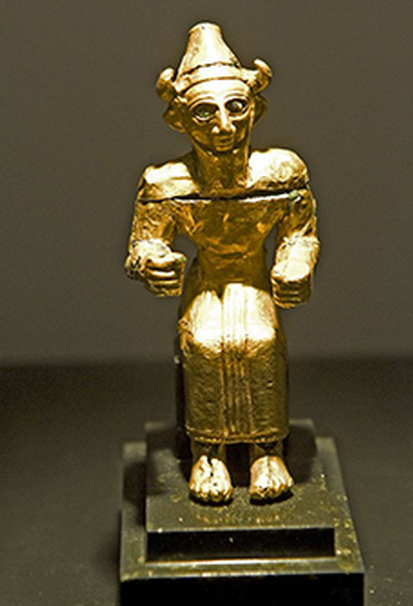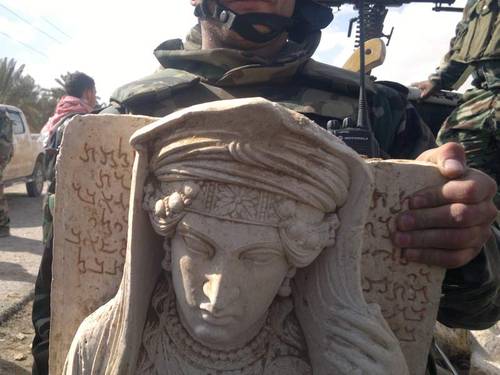aNewDomain — According to the FBI and Interpol, The Islamic State of Iraq and Syria (ISIS) has been looting invaluable cultural artifacts and works of art from museums in the territories it conquers and uses the proceeds to fund its murderous exploits.
ISIS stolen art sales to wealthy U.S. and European art collectors serve as the second largest of three pillars of funding for ISIS, reports say. Oil sales comprise the leading funding source with ransom payments serving as the smallest funding source, investigations show.
In essence, this means that Western art buyers are funding the bloody ISIS war — including its high-profile assassinations and beheadings. Here’s what we know so far.
The value of ISIS stolen art and artifacts? Huge.
For thousands of years, Syria has been the birthplace of diverse cultures and ancient kingdoms, including prehistoric tribes, Islamic societies, European crusaders, Persian merchants and the Abbasid and Ottoman Empires. Its treasures are priceless, historically and culturally.
 Now ISIS is selling them off to the highest bidder.
Now ISIS is selling them off to the highest bidder.
The Great Colonnade at Apamea, shown at right as it existed in 2010, is one of the victims of ISIS attacks on its own past. Apamea was founded by one of Alexander the Great’s generals and was once home to more than 100,000 inhabitants. The city was besieged by Julius Caesar and Cassius, the Roman senator who later assassinated Caesar. After standing for more than 2,300 years, little of the city may now remain.
This situation would have been impossible to imagine until only recently. Syria and surrounding countries have always taken great pains to preserve and protect the material remains of their rich cultural legacy.
The Syrian Civil War, which prominently features notorious groups like ISIS, changed everything.
Now there’s a tidal wave of concern regarding Syria’s cultural heritage in general, and some of civilization’s most valuable historical art and artifacts in particular.
The war threatens permanent damage to Syrian cultural heritage sites. That’s because objects from these sites are highly coveted in the international art and antiquities markets. And they’re now all subject to theft, looting and illicit trafficking by ISIS, UN reports reveal.
In response, the International Council of Museums now has prepared a “red list” of Syrian cultural artifacts most at risk of theft.
The Red List
It’s difficult, but not impossible, to create an accurate list of all missing art and artifacts from Syria, Iraq, and Afghanistan. But the International Council of Museums has prepared a fascinating set of documents. The red list spells out for museums and wealthy art collectors what not to buy.
In this way, these buyers can avoid inadvertently funding ISIS and other aggressive actors in this troubled area.
There are three red lists — for Syria, Afghanistan and Iraq. All three can be found readable in full, below.
List of Iraqi artifacts at risk
Profile of a cultural assasination attempt
 In Afghanistan, the Taliban infamously destroyed the Buddhas of Bamiyan in 2001. Like the Taliban, ISIS apparently holds little regard for its indigenous cultural history — and especially cultural history that predates the rise of Islam in the sixth century.
In Afghanistan, the Taliban infamously destroyed the Buddhas of Bamiyan in 2001. Like the Taliban, ISIS apparently holds little regard for its indigenous cultural history — and especially cultural history that predates the rise of Islam in the sixth century.
And then there’s the lure of selling off a despised cultural history to rich Europeans and Americans in order to fund a war against them.
And for ISIS, there’s an added benefit to the art sales beyond just helping it to buy more guns and explosives. Similar to the notorious World War II-era Nazi art lootings, ISIS’s ravaging of Syria’s rich cultural history will make it more difficult for Syrians in the future to remember their own past.
Regardless of whether ISIS succeeds or fails, this is a subtle and insidious form of cultural assassination.
INTERPOL, FBI and UNESCO: The Game Plan
INTERPOL already maintains a database of stolen art that contains some 45,000 pieces of stolen art. Only a fraction of this stolen art comes from Syria, Iraq, and Afghanistan. That’s because much of the stolen art has not even been officially reported as stolen — yet.
 The FBI established a rapid deployment Art Crime Team in 2004 when the aftermath of the U.S. invasion of Iraq resulted in the theft of Iraqi art objects. The team is comprised of 14 special agents, each responsible for addressing art and cultural property crime cases in an assigned geographic region. Art Crime Team agents receive specialized training in art and cultural property investigations and assist in art-related investigations worldwide in cooperation with foreign law enforcement officials and FBI legal attaché offices.
The FBI established a rapid deployment Art Crime Team in 2004 when the aftermath of the U.S. invasion of Iraq resulted in the theft of Iraqi art objects. The team is comprised of 14 special agents, each responsible for addressing art and cultural property crime cases in an assigned geographic region. Art Crime Team agents receive specialized training in art and cultural property investigations and assist in art-related investigations worldwide in cooperation with foreign law enforcement officials and FBI legal attaché offices.
Since its inception, the Art Crime Team has recovered more than 2,650 items valued at over $150 million.
Irina Bokova, director-general of UNESCO, said she welcomes the adoption of a new UN Security Council Resolution 2199 which condemns the destruction of cultural heritage and adopts legally-binding measures to counter illicit trafficking of antiquities and cultural objects from Iraq and Syria. Bokova said:
The adoption of resolution 2199 is a milestone for enhanced protection of cultural heritage in Iraq and Syria, extending to Syria the prohibition of trade of cultural objects already in place for Iraq since 2003. It is also a clear recognition that the pillage, destruction and trafficking of cultural heritage are more than a cultural tragedy – this is also a security and political imperative to be taken into account in all peace efforts.”
“Pillage of Iraq’s and Syria’s culture has reached an unprecedented scale in Iraq and Syria,” she added. “It fuels the conflicts by providing revenues for armed groups and terrorists. This resolution acknowledges that cultural heritage stands on the frontline of conflicts today, and it should be placed at the frontline of security and political response to the crisis.”
UN Resolution 2199:
Here is a list of Afghan artifacts at risk (originally prepared in 2006):
Red list of Afghan artifacts at risk
Check out Ted Rall’s commentary on ISIS stolen art here.
For aNewDomain, I’m Tom Ewing.
Photo credit: UNESCO Palmyra Syria
Photo credit: The Buddhas of Bamiyan













